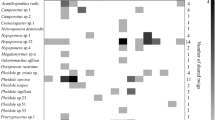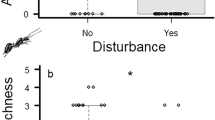Abstract
Twigs in leaf litter represent an important nesting resource for ant colonies. Twig diameter strongly influences the occupation of twigs by ants, possibly determining the size of colonies. Given that uncolonized twigs are common in leaf litter, we tested the hypothesis that ant species occupy twigs with a similar size (i.e., resource use overlap). In addition, we expected that colony size at assemblage and species levels were related to twig diameter because twig size may hinder nest occupation. We analyzed all twigs present in 112 4 × 4 m plots, summing 1792 m2 of leaf litter in 16 Atlantic Forest sites. We separated the twigs occupied by ants, counted the number of individuals, and measured twig diameter. We recorded 701 twigs occupied by 28 ant species. At the species level, we detected four twig size classes, with preference for twigs between 11.5 and 16.1 mm in diameter. Assemblage-wide, we found a significant relation between colony size and twig size. In addition, many ant species did not show a relationship between colony size and twig size, suggesting that ant species drive the general relationship by selecting different twig size classes.



Similar content being viewed by others
References
Aguinis H, Gottfredson RK, Joo H (2013) Best-practice recommendations for defining, identifying, and handling outliers. Organ Res Methods 16:270–301. https://doi.org/10.1177/1094428112470848
Ahuatzin DA, Corro EJ, Jaimes AA et al (2019) Forest cover drives leaf litter ant diversity in primary rainforest remnants within human-modified tropical landscapes. Biodivers Conserv 28:1091–1107. https://doi.org/10.1007/s10531-019-01712-z
Armbrecht I, Perfecto I, Vandermeer J (2004) Enigmatic biodiversity correlations: ant diversity responds to diverse resources. Science 304:284–286
Auguie B (2017) gridExtra: Miscellaneous Functions for "Grid" Graphics. R package version 2.3. https://CRAN.R-project.org/package=gridExtra
Baccaro FB, Rocha IF, del Aguila BEG et al (2013) Changes in ground-dwelling ant functional diversity are correlated with water-table level in an amazonian terra firme forest. Biotropica 45:755–763
Baccaro FB, Feitosa RM, Fernandez F, Fernandes IO (2015) Guia para os gêneros de formigas do Brasil. Editora INPA, Manaus
Barroso SC, Longui EL, Fernandes TT, Oliveira CM, Ferreira A, Silva RR, Morini MSC (2020) Twigs occupied by Pheidole Westwood, 1839: is there a difference between species? Biota Neotrop 20:e20190897
Byrne MM (1994) Ecology of twig-dwelling ants in a wet lowland tropical forest. Biotropica 26:61–72
Carvalho KS, Vasconcelos HL (1999) Forest fragmentation in central Amazonia and its effects on litter-dwelling ants. Biol Conserv 91:151–157
Carvalho KS, Vasconcelos HS (2002) Comunidade de formigas que nidificam em pequenos galhos da serrapilheira em floresta da Amazônia Central, Brasil. Rev Bras Entomol 46:115–121
Castaño-Meneses G, Mariano CF, Rocha P, Melo T, Tavares B, Almeida E, Silva L, Pereira TPL, Delabie JHC (2015) The ant community and their accompanying arthropods in cacao dry pods: an unexplored diverse habitat. Dugesiana 22:29–35
Costa-Milanes CB, Majer JD, Castro PTA, Ribeiro SP (2017) Influence of soil granulometry on average body size in soil ant assemblages: implications for bioindication. Perspect Ecol Conserv 15:102–108
Cptec-Inpe (2020) http://clima.cptec.inpe.br/. Accessed 04 Feb 2020
Crawley MJ (2013) The R book. Wiley, Chichester
da Silva RR, Brandão CRF (2014) Ecosystem-wide morphological structure of leaf-litter ant communities along a tropical latitudinal gradient. PLoS ONE 9:e93049. https://doi.org/10.1371/journal.pone.0093049
Fagundes R, Anjos DV, Carvalho R, Del-Claro K (2015) Availability of food and nesting-sites as regulatory mechanisms for the recovery of ant diversity after fire disturbance. Sociobiology 62:1–9
Fernandes TT, Silva RR, Souza DR, Araújo N, Morini MSC (2012) Undecomposed twigs in the leaf litter as nest-building resources for ants (Hymenoptera: Formicidae) in areas of the Atlantic Forest in the southeastern region of Brazil. Psyche J Entomol 2012:1–8
Fernandes TT, Souza-Campana DR, Silva RR, Morini MSC (2018) Ants that frequently colonize twigs in the leaf litter of different vegetation habitats. Sociobiology 65:340–344
Fernandes TT, Dattilo W, Luna P, Silva RR, Mayumi CO, Morini MSC (2019a) Ant occupation of twigs in the leaf litter of the Atlantic Forest: influence of the environment and external twig structure. Trop Conserv Sci 12:1–9
Fernandes TT, Silva RR, Souza-Campana DR, Silva OGM, Morini MSC (2019b) Winged ants (Hymenoptera: Formicidae) presence on twigs in the leaf litter of Atlantic Forest. Biota Neotrop 19:e20180694
Fernandes TT, Dáttilo W, Silva RS, Luna P, Braz AB, Morini MSC (2020a) Cohabitation and niche overlap in the occupation of twigs by arthropods in the leaf litter of Brazilian Atlantic Forest. Insect Soc. https://doi.org/10.1007/s00040-020-00753-w
Fernandes TT, Silva RS, Souza-Campana DR, Silva NS, Silva OGM, Morini MSC (2020b) Occurrence of ants (Hymenoptera: Formicidae) in both leaf litter and twigs in Atlantic Forest. Sociobiology 67:163–172
Ferro ML, Carlton CE (2011) A practical emergence chamber for collecting Coleoptera from rotting wood, with a review of emergence chamber designs to collect saproxylic insects. Coleopts Bull 65:115–124
Gomes DS, Almeida FS, Vargas AB, Queiroz JM (2013) Resposta da assembleia de formigas na interface solo-serapilheira a um gradiente de alteração ambiental. Iheringia Sér Zool 103:104–109
Hölldobler B, Wilson EO (1990) The ants. Harvard University Press, Cambridge, p 732
Jiménez-Soto W, Philpott SM (2015) Size matters: nest colonization patterns for twig-nesting ants. Ecol Evol 5:3288–3298
Joly AC, Metzger JP, Tabarelli M (2014) Experiences from the Brazilian Atlantic Forest: ecological findings and conservation initiatives. New Phytol 204:459–473
Kaspari M (1996) Testing resource-based models of patchiness litter ant assemblages. Oikos 76:443–454
Khalife A, Keller RA, Billen J, Garcia FH, Economo EP, Peeters C (2018) Skeletomuscular adaptations of head and legs of Melissotarsus ants for tunnelling through living wood. Front Zool 15:30
Kimber A, Eggleton P (2018) Strong but taxon-specific responses of termites and wood-nesting ants to forest regeneration in Borneo. Biotropica 50:266–273
Lester PJ, Abbott KL, Sarty M, Burns KC (2009) Competitive assembly of South Pacific invasive ant communities. BMC Ecol 9:3
Longino JT (2003) The Crematogaster (Hymenoptera, Formicidae, Myrmicinae) of Costa Rica. Zootaxa 151:1–150
Martins Segundo GB, Biseau JC, Feitosa RM, Carlos JE, Sá LR, Fontenelle MTMB, Quinet Y (2017) Crematogaster abstinens and Crematogaster pygmaea (Hymenoptera: Formicidae: Myrmicinae): from monogyny and monodomy to polygyny and polydomy. Myrmecol News 25:67–81
Mazerolle MJ (2019) AICcmodavg: Model selection and multimodel inference based on (Q)AIC(c). R package version 2.2-2. https://cran.r-project.org/package=AICcmodavg
Mertl AL, Wilkie KTR, Traniello JFA (2009) Impact of flooding on the species richness, density and composition of amazonian litter-nesting ants. Biotropica 41:1–9
Powell S, Costa AN, Lopes CT, Vasconcelos HL (2011) Canopy connectivity and the availability of diverse nesting resources affect species coexistence in arboreal ants. J Anim Ecol 80:352–360
R Core Team (2019) R: a language and environment for statistical computing. R Foundation for Statistical Computing, Vienna, Austria. https://www.R-project.org/
Reis-Jr R, Oliveira ML, Borges GRA (2013) RT4Bio: R Tools for Biologists (RT4Bio). R package version 1.0
Ribas CR, Schoereder JH, Pic M, Soares SM (2003) Tree heterogeneity, resource availability, and larger scale processes regulating arboreal ant species richness. Austral Ecol 28:305–314
Sagata K, Mack A, Wright D, Lester PJ (2010) The influence of nest availability on the abundance and diversity of twig-dwelling ants in a Papua New Guinea forest. Insect Soc 57:333–341
Santos RS, Guerra MBB, Ambrogi BG, Sousa-Souto L (2017) Nest refuse leaf-cutting ants as a growing substrate for organic farming systems. Org Agric 8:315–324. https://doi.org/10.1007/s13165-017-0199-1
Satoh T, Yoshida T, Koyama S, Yamagami S, Takata M, Doi H, Kurachi T, Hayashi S, Hirobe T, Yasuo H (2016) Resource partitioning based on body size contributes to the species diversity of wood-boring beetles and arboreal nesting ants. Insect Conserv Div 9:4–12
Schumacher MV, Brun EJ, Rodrigues LM, Santos EM (2003) Retorno de nutrientes via deposição de serapilheira em um povoamento de Acácia-negra (Acacia mearnsii de Wild.) no Estado do Rio Grande do Sul. Rev Árvore 27:791–798
Silva RR, Brandão CRF (2010) Morphological patterns and community organization in leaf-litter assemblages. Ecol Monogr 8:17–124
Slowikowski K (2019) ggrepel: Automatically position non-overlapping text labels with ‘ggplot2’. R package version 0.8.1. https://CRAN.R-project.org/package=ggrepel
Souza DR, Fernandes TT, Nascimento JRO, Suguituru SS, Morini MSC (2012) Characterization of ant communities (Hymenoptera: Formicidae) in twigs in the leaf litter of the Atlantic Rainforest and eucalyptus trees in the southeast region of Brazil. Psyche. J Entomol 2012:1–12
Souza-Campana DR, Silva RR, Fernandes TT, Silva OGM, Saad LP, Morini MSC (2017) Twigs in the leaf litter as ant habitats in different vegetation habitats in southeastern Brazil. Trop Conserv Sci 10:1–12
Suguituru SS, Morini MSC, Feitosa RM, Silva RR (2015) Formigas do Alto Tietê. Canal 6 Bauru, Sao Paulo
Venables WN, Ripley BD (2002) Modern applied statistics with S, 4th edn. Springer, New York (ISBN 0-387-95457-0)
Wickham H (2016) ggplot2: Elegant graphics for data analysis. Springer, New York
Yamaguchi T (1992) Interspecific interference for nest sites between Leptothorax congruus and Monomorium intrudens. Insect Soc 39:117–127
Zuur AF, Ieno EN, Elphick CS (2010) A protocol for data exploration to avoid common statistical problems. Methods Ecol Evol 1:3–14
Acknowledgements
We would like to thank the São Paulo State Research Support Foundation (FAPESP) (Protocol no. 2013/16861-5; coordination of MSC Morini), the Teaching and Research Support Foundation (FAEP), and the National Council for Scientific and Technological Development (CNPq; Protocol no. 32363/212-2) for their financial support. RPSA, JAS and TTF were financed by the Coordination for the Improvement of Higher Education Personnel—Brazil (CAPES)—Finance Code 001. In addition, we would like to thank Arleu Viana-Junior for the contributions to the statistical analyses, and two anonymous reviewers for contributions to the manuscript.
Author information
Authors and Affiliations
Corresponding author
Ethics declarations
Conflict of interest
The author(s) declared that there is no conflict of interest with respect to the research, authorship, and/or publication of this article.
Supplementary Information
Below is the link to the electronic supplementary material.
Rights and permissions
About this article
Cite this article
Almeida, R.P.S., Andrade-Silva, J., Silva, R.R. et al. Twigs in leaf litter: overlap in twig size occupation by nesting ants. Insect. Soc. 68, 199–206 (2021). https://doi.org/10.1007/s00040-021-00816-6
Received:
Revised:
Accepted:
Published:
Issue Date:
DOI: https://doi.org/10.1007/s00040-021-00816-6




